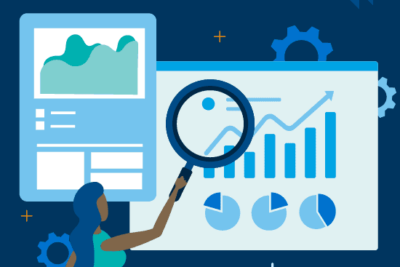What does a data management platform actually do?
5 ways a data management platform can benefit your college
June 30, 2023, By Earl Sires, Strategic Writer
To anyone who doesn’t work with raw data directly, data management might seem esoteric. It certainly sounds good to improve data management, but in a tangible sense, what does that mean? What benefits do staff, faculty, and students gain from better data management?
In this blog post, we answer that question with examples of the transformative impact that a data management platform can have on higher education.
What is a data management platform?
A data management platform gathers data from your disparate campus databases and platforms—such as your LMS, your SIS, and your CRM—and then compiles and standardizes that data to establish a single, shared source of truth across campus. With trustworthy data stored in a secure location (known as a data warehouse), a data management platform allows your campus to govern data, assign data access based on user roles, put data into action, and develop customized dashboards.
EAB’s data management platform, Edify, is built specifically for higher education. Edify serves as a data hub for all of the systems that higher ed already uses, from enrollment and fundraising CRMs to student success platforms. Edify automatically standardizes data from those systems so that it is clean, accessible, and trustworthy. Edify uses plain-language terminology for its data fields to ensure everyone understands the data they access.
See what EAB partners achieved with Edify, EAB’s data management platform
1. Improve compliance reporting
IPEDS reporting (among other compliance reports) is a necessity for any institution receiving state or federal funding, but compiling and submitting IPEDS data is tedious and time-consuming. Many institutions have a staff member whose primary function is to complete such reports. But what might that staff member achieve if they could complete reports faster without compromising accuracy?
Without a data management platform, the institutional research department (or whoever compiles IPEDS data at your institution) must spend hours querying data sources in different departments, manually combining data sets in Excel, and writing emails to track down data. And once all the data is gathered and submitted, if an IPEDS error check finds inaccuracies, it can be a nightmare to find and rectify the source of the error.
If all that data were compiled, cleansed, and standardized in a data management platform year-round, the time required to submit the report would be drastically cut down. Some EAB partner institutions see as much as a 75% decrease in the time required to submit each section of their IPEDS reports (which equates to upward of 90 hours annually). What might your institution do with all of that extra staff time?
2. Retain more students and close equity gaps
Retention and student equity efforts rely heavily on data; without establishing benchmarks and tracking progress toward KPIs, there is no meaningful way to judge progress. But higher ed data systems often lock data away, making student data difficult to access, understand, and apply. That is where a data management platform can make a significant difference.
Compiling data from across a student’s lifecycle—from prospect to enrolled student to graduate and beyond—offers a broad understanding of an individual student’s profile. A data management platform makes this understanding possible by bringing in data from all campus systems. That data can be used to segment the student population into subsets, allowing you to determine which subpopulations would benefit most from conversations about specific types of support, such as financial aid, academic assistance, and career planning.
This granular perspective has a twofold effect. First, it improves retention by giving students the specific form of support they are most likely to benefit from. It also makes your campus more equitable by equipping your institution to develop subset-specific programming and initiatives, then measure how those efforts perform.
Explore the University of Montana’s data for student equity work
At a macro level, accurately tracking demographic data such as race and ethnicity is critically important to measure equity goals. When this data is stored in varied systems rather than in a single, standardized location, administrators and decision-makers may not have an accurate understanding of issues the campus needs to address. Building a single source of truth (i.e., a data warehouse) ensures everyone is working from the same numbers.
How does a data warehouse differ from a data management platform?
A data warehouse (or central storage location for campus data) is a critical component of a data management platform. Data warehouses compile and store data, making it possible to enact further data management (including data governance, lineage tracking, definitions, role-based access permissions, analytics, dashboards, and more).
3. Standardize department reviews and faculty line requests
Conversations around hiring and salary are challenging and sensitive, particularly when faculty, staff, or other stakeholders perceive subjectivity in decisions. Data and objective metrics build trust around processes like faculty line requests and annual reviews.
It is difficult to standardize review processes when each department gathers different data, siloes that data in its own database, and labels the data with department-specific codes. With data scattered around campus and stored in varied formats, there is no way to ensure each chair can provide the same data for review—or that the data provided is trustworthy.
A data management platform allows for the creation of standardized reports (including accurate metrics for enrollments per section, faculty salaries, and others) for department chairs, which in turn allows higher-level decision makers to formalize the data submission process and timeline. When every department has access to the same metrics, they can be evaluated fairly against those metrics.
4. Improve advancement efforts through more intelligent fundraising
As Advancement gets more targeted in its approach to fundraising appeals, it has become more reliant on data. Rather than broad call lists and mass mailers to alumni, modern approaches to fundraising use segmentation and analytics to personalize and customize outreach to each potential donor. As with other efforts, the better quality the data a fundraiser has, the more targeted and relevant that fundraiser can make their outreach.
A comprehensive data management platform brings together all available data on alumni. From preadmissions academic performance to activities during enrollment and postgraduate participation, fundraisers can gain a clear picture of who their prospective donors are, how much affinity each alumnus has, and what type of outreach they might respond to.
With this data in hand, Advancement departments can predict the likelihood that annual fund participation and major gift donation campaigns will succeed, allowing fundraisers to spend time and money where it will have the greatest impact.
5. Facilitate agility while keeping data secure
As stewards for students, schools are responsible for maintaining and securing private student data. Institutions additionally have proprietary and financial data that requires protection and care. This responsibility is especially in focus during transition events, such as migrations from one database to another, or software upgrades to critical systems. These valid security concerns can prevent institutions from making needed technology upgrades.
During technology transitions, data management platforms protect data from exposure. With data stored centrally (rather than in each individual system), changing from one student information system to another is less high-stakes, as the most important piece of the puzzle (the data itself) is not at risk during the transition. In this way, data management platforms build agility into technology procurement and implementation. Schools are no longer bound to an ERP ecosystem—they can use whichever system is best suited to their use case and draw data from a central, secure, standardized location.
Additionally, a centralized management platform allows IT staff to set and enforce data access and entry protocols. For security (and practical) reasons, granting different users access to only the data they need is much easier with a centralized platform than if each department creates and maintains its own data source. Data management platforms also allow admins to track who accesses data (and when)—an additional step toward securing sensitive information.
Data management for your needs
The list of use cases above is by no means comprehensive. Data management platforms can improve nearly any process or help you progress toward any imperative. The true determinant of what you can achieve with a data management platform is your own priorities.
EAB’s Edify is designed specifically to work with higher ed’s most common systems and platforms, and EAB has decades of experience helping institutions achieve their goals. Whether you need support in your enrollment, retention, advancement, reporting, or other efforts, Edify and EAB’s data experts can make it happen. Speak with an EAB expert if you are interested in learning more.

More Blogs

Why data governance matters for university strategy—and why most data governance projects fail

Is your data ready to support COVID-19 recovery?
